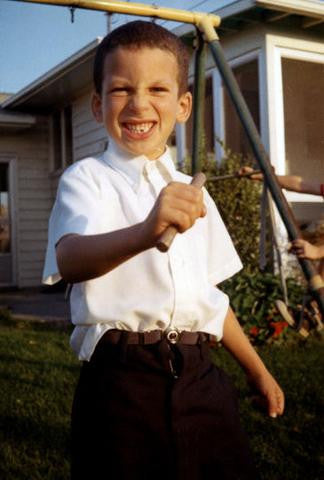Seth Godin wondered whether he was stupid.
Years before he’d write 18 best-selling books and launch one of the most revered blogs in the world, Godin made what he calls the most expensive mistakes of his life — one that likely cost him billions of dollars. Though it would make some of his eventual readers rich.
It was 1993 and Godin, who headed an email marketing company at the time, saw the emergence of the web before most. What he initially saw was the web’s full potential. Instead of building a search engine or launching an online bookstore, as now he says he could have … Godin looked at the web and rolled his eyes:
I thought it was stupid. I said it would never work.
A year and a half passed, but Godin’s skepticism didn’t …
It wasn’t until several years later, as Godin continued to build his direct marketing outfit that would eventually be sold to Yahoo for $30 million, that he realized what was actually going on beneath the surface.
I figured out I hadn’t been stupid, but afraid. If you take that leap out into a void you might land hard on concrete.
It’s the same fear likely keeping you from being your best …
And the time you have to recognize and overcome it, according to Godin, is running out fast.
It Has a Name?
The invisible form of self-sabotage Godin says kept him from taking a leap is one that convinces us …
It’s easier and safer to keep doing what we’re doing.
In his book The War of Art, Steven Pressfield name it The Resistance and it might best be described as the enemy of all success; that little voice in the back of our heads that tells us we’re not good enough and causes us to sabotage our own success. The Resistance grows in strength the closer we get to achieving our goals and must be recognized and overcome for ambition to become reality.

I stood up in my office and shouted, ‘Why didn’t anyone tell us about this?’ No one was talking about this until Pressfield named it.
The Resistance is rooted in biology; it’s the almond-shaped part of your brain called the amygdala and is actually responsible for keeping our ancestors alive. It tells us when we ought to be afraid and activates our “fight or flight” reflex.
For instance, when your caveman ancestors came face to face with a sabertooth tiger, your amygdala instantly put them on high alert, prompted them to run away in terror, so that one day you could be born to read this.
But the amygdala, or lizard brain as Godin calls it, isn’t suited for today’s post-industrial world, where playing it safe is actually dangerous.
In a nutshell, Godin argues we’ve been brainwashed to show up, conform, and not take risks because they might not work. While this pleases the amygdala (which wants us to be careful and avoid risk), it often prevents us from achieving our best.
To win our battles with the Resistance, Godin says we have to quiet or ignore the lizard brain:
“I’ve been battling the lizard brain for forty or fifty years. There was a time it was needed for survival but those instincts today hold us back, keep us from raising our hands, and prevent us from showing up as our best selves.”
Be careful ...
Dancing with our fear doesn't mean doing something insane or taking a risk that can hurt ourselves and others. Instead, it's the easily overlooked moments of generosity and bravery that we avoid. That's where we're capable of doing our best work.
It’s this zone that’s in Godin’s crosshairs now. And he’s asking you to pull the trigger before it’s too late.
Art vs. Artificial Intelligence
Can what you do at work be written down step-by-step?
If so, Godin argues, the boss can probably find someone to do it cheaper or eventually swap the person doing the job for a robot. With advances in machine learning and artificial intelligence, the question becomes: What am I doing that a robot can’t?
Artificial intelligence can’t do art. It can do a thousand other things better than people, but not art.
What’s art?
It’s not a painting necessarily, but something Godin describes as original, generous, might not work, and is done to change someone for the better.
“We’ve all been artists at some point,” Godin promises. “You’ve felt it when you’ve spoken up in a meeting or decided to fix something even though it’s not your job.”

Godin wants us to do more of this.
In fact, he suggests we must if we are to become indispensable before robots take our jobs and we no longer have the opportunity to do this type of work.
We have computers that can play music better than people but no computer can play like Yo-Yo Ma because he improvises and doesn’t play the music as it’s written. This type of work is open to all of us, but we have to hurry.
It’s why Godin recently wrote What To Do When It’s Your Turn, an urgent call to do the work Godin says we’re hiding from. It’s a different kind of book in two ways.
 First, Godin designed it himself and wrote it for people who may not ordinarily read books. It’s more like a full-color, high-end magazine with illustrations designed to help us begin doing important work that matters.It’s a different kind of book in two ways.
First, Godin designed it himself and wrote it for people who may not ordinarily read books. It’s more like a full-color, high-end magazine with illustrations designed to help us begin doing important work that matters.It’s a different kind of book in two ways.
Secondly, it was made to share and start conversations within groups…
It’s why after trimming the book from several hundred pages to 160, Godin is also distributing it nontraditionally. The book is packaged and priced to share; if you buy one Godin sends you two and so on all the way up to a 120 copy bundle for $999 aimed at larger groups that desire change.
“I’m trying to get people to have a conversation, not to buy a book. I’m fortunate because I don’t have to sell a lot of books to make this project work. Instead, I’m looking at how people are using the book. Did I change ten or one hundred groups? If so, it was worth it.”
Finding this zone where the ground doesn’t always feel solid and there’s no map to guide our next steps requires a lot of finesse, and is why Godin includes a variety of inspiring examples of those who have already taken the leap successfully.
To date, more than 150,000 copies have been sold.
Instigate to Win
Instead of a zero-sum game that requires someone to lose…
Godin defines winning as changing a culture for the better: “My job isn’t to win. It’s to instigate.”
One way Godin instigates is by purposefully treating different people differently.
It’s why he checks the book’s monthly sales trends to better understand those who are buying a two pack of books versus those purchasing a 120 book bundle. “It’s important to be aware of who your heavy users are and what they want,” Godin explains. “I was thrilled to discover that customers are buying more than one 120-pack.”
As impressive as it is selling hundreds of books to individual customers … after 18 bestsellers, Your Turn might be Godin’s last book on paper.
I love books and always will but you can’t push uphill forever.
What does that mean?
The revelation came about when we asked Godin about the most effective way to teach in the future. After all, that’s what Godin has been — a teacher — since the age of sixteen when he began showing people how to canoe.
So after eighteen books, speeches that have been viewed millions of times, and designing an altMBA program to help high performers become better leaders, how does Godin plan to teach tomorrow and beyond?

It’ll likely be through unique combinations of video and community, Godin suggests.
I’ve had a great run with books but the goal isn’t to write books. I’ll keep writing but the goal is to change people and I’ll try to do that in any way that makes me proud.
Read more
- How Death Wish Coffee Made $2,083 a Minute by Winning the Super Bowl
- Ryonet Finds Ease and Speed for Both Its Online Wholesale Businesses
- How a Seller of Outlandish Party Costumes Optimized Its Warehouse to Grow 400% & Compete With Amazon
- Holiday Disaster to a $128M Global Brand: Behind Gymshark’s Multi-Channel Empire
- ThirdLove Relies on Data and Platform Stability to Drive 347% YoY Sales Growth
- How a Music Industry Marketing & Technology Agency Uses Shopify Plus to Grow Direct-to-Fan Sales
- How to Build a Multi-Brand Ecommerce Growth Machine
- How A Family Business Left Magento For Shopify Plus & Immediately Doubled Its Conversion Rate While Changing Lives
- 11 Ecommerce Checkout Best Practices: Improve the Checkout Experience and Increase Conversions


